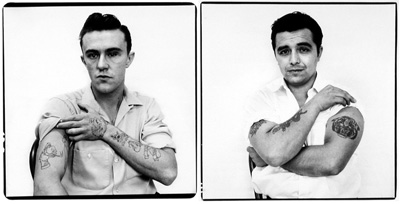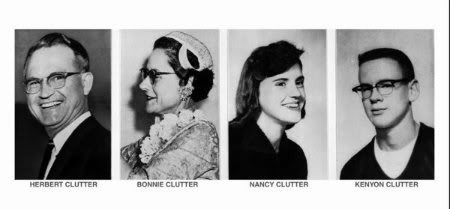In Cold Blood by Truman Capote
The village of Holcomb stands on the high wheat plains of western Kansas, a lonesome area that other Kansans call “out there.”
— Truman Capote, In Cold Blood

These are the faces of the two men who destroyed a family, Richard Hickock and Perry Smith, in Truman Capote’s cold and heartbreaking true crime novel In Cold Blood. The novel, first published in 1966, meticulously details the lead up to and the aftermath of the slaying of the Clutter family in the small town of Holcomb, Kansas, a crime that rocked the foundations of the community and sparked a nationwide manhunt for the two killers.
Using his extensive notes collected from interviews with the killers, the agents pursuing them, the residents of Holcomb and those close to the Clutter family, Capote paints a grim picture of a robbery turned to grisly murder. The interviews, conducted over seven years between the murders in 1959 and the novel’s completion in 1966, provided Capote and his cousin Harper Lee with over ten thousand pages of notes to draw from when reconstructing the events. This level of detail and dedication of Capote is instrumental in painting a picture of the people involved, and creating a rawness and empathy for both the victims and even the killers.
The novel begins with an account of the daily life of the Clutter family in rural Kansas, in the days leading up to their murders on November 15, 1959. The patriarch Herbert Clutter is described as a well liked and respected member of Holcomb, who is known as a fair and generous employer amongst his farmhands. His wife Bonnie is clinically depressed and unable to leave the house on most occasions, a fact generally accepted by friends of the family. The Clutters had two adult daughters who had since moved out of home, Eveanna and Beverly, with the two younger children, Nancy and Kenyon, still living with their parents.
Capote sketches out the particulars of the lives of the inhabitants of River Valley Farm. Nancy is an extremely popular girl in the community who has a steady boyfriend in the form of Bobby Rupp. Kenyon is an intelligent boy who has but one friend, who recently started seeing a girl, and enjoys working with electronics. The hopes and dreams of the family are laid bare, which makes it all the more heartbreaking to know that they will never be fulfilled. The author does not detail the murders in complete chronological order, preferring to withhold those awful moments until half way through the novel. Rather, he delves into the backgrounds of the two killers, whose turbulent lives seemed to lead all along to the fateful Sunday.
Richard Eugene Hickock was born on June 6, 1931 in Kansas City to hardworking parents that were unable to send him to college. He was a promising athlete in high school until an automobile accident left him with lasting injuries. He took a job as a mechanic, married once and had three children but then left his wife for his mistress. This too ended in divorce, and Hickock soon turned to a life of petty crime after being unemployed for a long period of time to make ends meet, favouring check fraud and theft, the crimes which eventually landed him in prison with Perry Smith.
Perry Smith life was a tale of failure, abuse and woe. He was born on October 27, 1928 to “Flo” Buckskin and “Tex” John Smith, two rodeo performers in Huntington, Nevada. Smith grew up in a broken family after his parents divorced, his mother becoming an alcoholic from his father’s bootleg whiskey business. He and his siblings lived with his alcoholic mother in San Francisco until she died. They were then placed in a Catholic orphanage where Smith was abused by the nuns for his lifetime chronic bed-wetting problem. He was then placed in a Salvation Army orphanage where one of the nuns tried to drown him. He kept a deep seated hatred for her the rest of his life.
After a stint in the Merchant Marine and later the Army during the Korean War, Smith spent time in Washington state, where after a purchasing a motorcycle he was involved in a terrible accident which left his legs permanently disabled. He was also left with a drug abuse problem as he consumed huge amounts of aspirin to control the pain. Two of Smith’s three siblings committed suicide early in their life, and his sister refused to talk to him after learning of his criminal activities, fearing for her own safety.
Smith’s story enraptured Capote so much more so than that of Hickcock, and this is quite evident throughout the novel. Smith is often shown to be a victim of the circumstances of his life, and as a thoughtful but emotionally stunted individual whose destiny was shaped by the abuse he suffered through. Hickcock on the other hand was largely glossed over by the author, seemingly dismissed as a petty thug who got in too much over his head. Throughout the years there has been intense speculation whether Capote, as a homosexual, had developed feelings for Smith that went further than their friendship. Such speculation can neither be proved or disproved though, and no one will ever get any answers from either men.

The power of this novel is in the way that it transports you back into the hearts and minds of the people of Holcomb in 1959. Capote goes into obsessive detail over extremely minor characters and their daily lives, publishes letters sent to the killers, and uses creative fictional devices to describe environments and scenes in vivid detail. You end up occupying the lives of the characters, just as Capote did for six years while he waited for the lives of the murderers to end in Lansing state prison in 1966. For end they must, and end they do. You know throughout the whole novel that this is the inevitable conclusion to the entire saga. The killers at the end of a rope.
The way Capote keeps the reader engaged throughout the novel whilst knowing the conclusion to it is by withholding the exact order of the events of the murders until the murderers are captured in Nevada. They are tracked throughout the continental United States and Mexico by agents of the Kansas Bureau of Investigation, led by agent Alvin Dewey. Agent Dewey is long suffering, his home life inseparable from his work while the investigation continues. You feel for him as Smith and Hickock constantly elude capture, even venturing through Garden City, Kansas at one point.
When they are captured in Nevada, Dewey is triumphant. Though his only eventual reward is to hear a firsthand account of how an innocent Kansas family was methodically slaughtered by two men, obliterating them from existence. The most powerful lines in the book come at the end of this confession, describing sum total of what the killers gained from the crime. Duntz asks Smith:
Added up, how much money did you get from the Clutters?
And Smith replies:
Between fourty and fifty dollars
In Cold Blood is a powerful novel, and a story of intense dread and heartbreak. It stands out as a literary classic of the True Crime genre, and although some facts claimed to be one hundred percent accurate by Capote have since been disputed, the novel’s level of detail and methodical descriptions of even investigative methods and court proceedings are exemplary.
The only criticisms I had with it are that my mind sometimes wandered in these uber-detailed sections, though I would not cut them from the novel. All parts of the novel served to construct a world in which the reader is placed to live as the Clutters, the residents of Holcomb and Dick Hickock and Perry Smith lived. And to relive a gruesome chapter of American history, where a simple farming family was murdered, in cold blood.